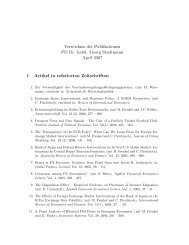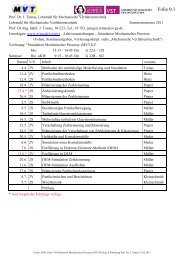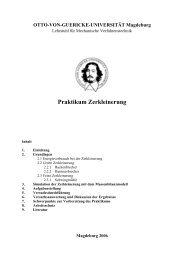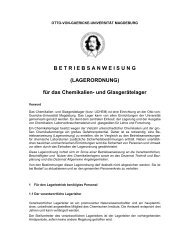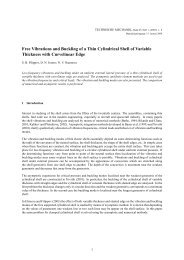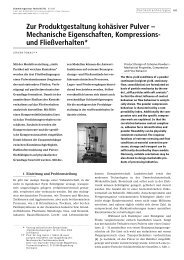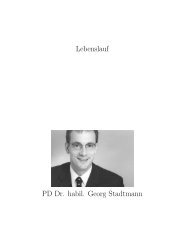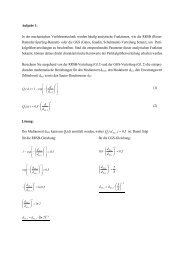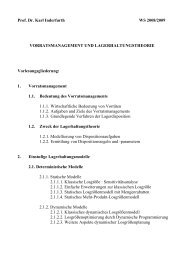2J. Tomasfeeding and dosing, as well as undesired effects such as widely spread residencetime distribution, time consolidation or caking, chemical conversions and deterioration<strong>of</strong> bioparticles. Finally, insufficient apparatus and system reliability <strong>of</strong>powder processing plants are also related to these flow problems. The rapid increasingproduction <strong>of</strong> cohesive to very cohesive nanopowders, e.g., very adheringpigment particles, micro-carriers in biotechnology or medicine, auxiliary materialsin catalysis, chromatography or silicon wafer polishing, make theseproblems much serious. Taking into account this list <strong>of</strong> technical problems andhazards, it is essential to deal with the fundamentals <strong>of</strong> particle <strong>adhesion</strong>, powderconsolidation and flow, i.e. to develop a reasonable combination <strong>of</strong> particle and<strong>continuum</strong> mechanics.The well-known failure hypotheses <strong>of</strong> Tresca, Coulomb and Mohr and Druckerand Prager (in Refs. [1, 2]), the yield locus concept <strong>of</strong> Jenike [3, 4] and Schwedes[5], the Warren–Spring equations [6–10], and the <strong>approach</strong> by Tüzün [12], etc.,were supplemented by Molerus [13–16] to describe the cohesive, steady-stateflow criterion. Nedderman [17, 18], Jenkins [19] and others discussed the rapidand collisional flow <strong>of</strong> non-adhering particles, as well as Tardos [20] discussedthe frictional flow for compressible powders without any cohesion from the fluidmechanics point <strong>of</strong> view. Additionally, the simulation <strong>of</strong> particle dynamics <strong>of</strong> freeflowing granular media is increasingly used, see, e.g., Cundall [21], Campbell[22], Walton [23, 24], Herrmann [25] and Thornton [26].Additionally, particle <strong>adhesion</strong> effects are related to undesired powder blockingat conveyer transfer chutes or in pneumatic pipe bends [27] in powder handlingand transportation, to desired particle cake formation on filter media [28, 29], towear effects <strong>of</strong> adhering solid surfaces [30, 31], fouling in membrane filtration,fine particle deposition in lungs, formulation <strong>of</strong> particulate products [32–35] or tosurface cleaning <strong>of</strong> silicon wafers [36–40, 133], etc.The force–displacement behaviors <strong>of</strong> elastic, elastic–<strong>adhesion</strong>, plastic–<strong>adhesion</strong>, elastic–plastic, elastic–dissipative, plastic–dissipative and viscoplastic–<strong>adhesion</strong> contacts are shown. Based on these individual theories, a general <strong>approach</strong>for the time and deformation rate dependent and combined viscoelastic,plastic, viscoplastic, <strong>adhesion</strong> and dissipative behaviors <strong>of</strong> a spherical particlecontact is derived and explained.2. PARTICLE CONTACT CONSTITUTIVE MODELSIn terms <strong>of</strong> particle technology, powder processing and handling, Molerus [13,14] explained the consolidation and non-rapid flow <strong>of</strong> dry, fine and cohesivepowders (particle diameter d < 10 µm) in terms <strong>of</strong> the <strong>adhesion</strong> forces at particlecontacts. In principle, there are four essential mechanical deformation effects inparticle–surface contacts and their force–response (stress-strain) behavior can beexplained as follows (Table 1):
<strong>Mechanics</strong> <strong>of</strong> <strong>nanoparticle</strong> <strong>adhesion</strong> — A <strong>continuum</strong> <strong>approach</strong> 3(1) elastic contact deformation (Hertz [41], Huber [42], Derjaguin [43], Bradley[44, 45], Cattaneo [46], Mindlin [47], Sperling [48], Krupp [49], Greenwood[50], Johnson [51], Dahneke [52], Thornton [53, 54], Sadd [55]), which is reversible,independent <strong>of</strong> deformation rate and consolidation time effects andvalid for all particulate solids;(2) plastic contact deformation with <strong>adhesion</strong> (Derjaguin [43], Krupp [56], Schubert[57], Molerus [13, 14], Maugis [58], Walton [59] and Thornton [60]),which is irreversible, deformation rate and consolidation time independent,e.g. mineral powders;(3) viscoelastic contact deformation (Yang [61], Krupp [49], Rumpf et al. [62]and Sadd [55]), which is reversible and dependent on deformation rate andconsolidation time, e.g., bio-particles;(4) viscoplastic contact deformation (Rumpf et al. [62]), which is irreversible anddependent on deformation rate and consolidation time, e.g., <strong>nanoparticle</strong>s fusion.This paper is intended to focus on a characteristic, s<strong>of</strong>t contact <strong>of</strong> two isotropic,stiff, linear elastic, smooth, mono-disperse spherical particles. Thus, this s<strong>of</strong>t orcompliant contact displacement is assumed to be small (h K /d



